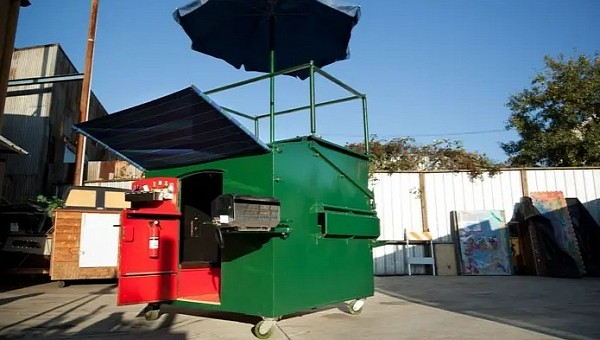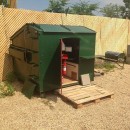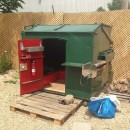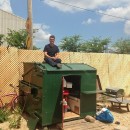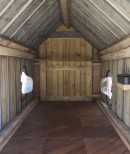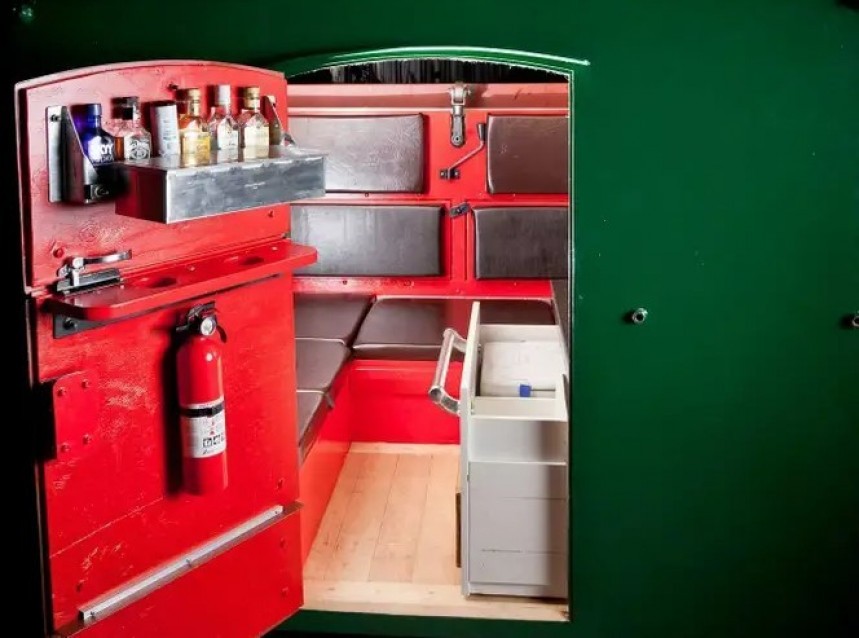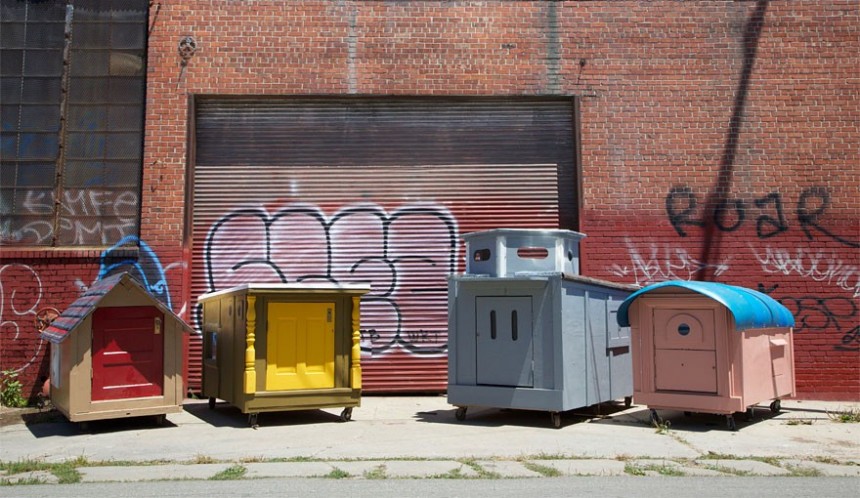One man’s trash is another man’s treasure, but for few other men is trash as valuable as it’s for Gregory Kloehn, an artist, designer and micro-home builder from Oakland, California. His Dumpster Home is perfect – and quite literal – proof of that.
These days, we hear and read a lot about tiny homes and other mobile living alternatives from van to bus conversions, and anything in between. Recent developments with the international health crisis and everything it brought along, working from home, the downsizing movement and, not least of all, the housing and economic crisis have propelled the once-niche tiny house movement into the spotlight.
Even with the incredible boost to the tiny house movement, which has led to a boost in the range of options available for those planning to transition, tiny house living remains prohibitively priced. Unless you’re willing or are skilled enough to do most of the work yourself, tiny living implies a starting cost that’s still putting many off.
Back in 2011, one man proved that tiny living didn’t necessarily have to be expensive. In fact, he showed that you could make a home virtually out of anything with reduced costs, as long as you were brave (or mad) enough to try it, and that you could even put a luxury spin on it, even with an incredibly compact layout. Case in point, a $2,000 city dumpster.
That man is artist, designer, plumber, and micro-home builder Gregory Kloehn, based in Oakland, California. His Dumpster Home is now iconic and is often referred to as one of the smallest and most creative examples of tiny living. The micro-home is also mobile, and can travel as far as you’re willing to push it. Kloehn put larger wheels under it specifically for this purpose, so it would move around the city at will.
As the name says, this home is a dumpster, but one that’s been repurposed and fitted with all the comfort creatures of a home. And then some. It features a mini-bar on the door, including servings of olives and other amuse-bouches that go with alcohol, an exterior barbecue, a shower (also exterior), a toilet, a kitchen, a lounge and bedroom (which are one and the same), and a rooftop deck. Finishes are granite for the countertops, hardwood floor, and stainless steel for the kitchen, so it has a real residential feel to it.
The Dumpster Home might make even the most passionate downsizers turn their nose at the kind of radical downsizing it proposes, but that would probably not bother Kloehn in the least. As he would explain in 2014 in a series of interviews with some of the biggest media outlets in the U.S., his goal with the project was to prove that you could make a home out of the most surprising and smallest space, especially in a city like New York, where housing was neither easily accessible nor affordable. He would spend the next summers living in the Dumpster Home, as if to prove that it was a practical housing alternative, even for long-term use.
It took Kloehn six months to complete the project, which is perhaps a record for him, since turnover is usually much quicker, days. But the result was astounding: the Dumpster Home has running water for the sink in the kitchen and the hidden toilet, as well as the exterior shower, thanks to a six-gallon (22.7-liter) tank. Once you hook it up for electricity, you have working lights and power for home appliances, like a cooler and a toaster oven. The kitchen also has a one-burner propane stove and some counter space to prep meals for one.
During daytime, there’s a couch in the middle that can seat up to three people. One of the benches hides the toilet, while the others integrate storage. The roof can pop up to reveal windows that allow in fresh air and natural light, and standing height. At night, the couch converts into a bed, and with the roof lowered, the dumpster becomes inconspicuous on city streets.
Because there’s only so much space inside, Kloehn added a shower on the outside, as well as a propane barbecue. Up on the roof is a deck that can easily support two people; just add a sun umbrella and you’re set for a party.
The idea of living in a dumpster and calling it a mobile home might come across as an oddity or, at best, some sort of artistic statement of the kind we’ve seen before, but the goal behind this project was a very serious one. It paved the way for the Homeless Homes Project, which Kloehn ran out of Oakland well into 2016, building micro-houses for the homeless. He only used the Dumpster Home to generate media attention into his initiative of using what he called homeless architecture to design habitats out of “trash,” which he gave out to the homeless.
Kloehn and the community he built designed and delivered dozens of homes for the homeless, and inspired similar projects in other U.S. cities and even abroad. One such micro-home, which was always built either with materials salvaged from city streets or donated by volunteers, took up to a week to complete, at a cost of under $100 – sometimes even less than half that amount. As photos in the gallery show, Kloehn’s micro-homes were both practical and nice-looking, aiming to offer the comfort and security of an actual home, but with a more compact layout, and the possibility of simply rolling it away to a new location.
As far as we can tell, the Project is no longer around: social media accounts haven’t been updated in years, and the official website is offline. Kloehn himself hasn’t posted anything about it since 2016, when he was happily reporting the delivery of another batch of new units, with help from the community and his network of volunteers.
As for the Dumpster Home, it was last spotted in Williamsburg, where Kloehn was still using it during the summer, before moving back to Oakland for the winter. In 2015, it was offered for rent at $1,200 per month or $200 per night, but whether it had any takers at this rate is unknown. We reached out to Kloehn for an update on his most famous micro-home and the Project is spearheaded, and will update the story when and if we hear back.
Until then, here’s the Dumpster Home to show that, with the right skill, downsizing and mobile living are simply a matter of thinking outside thebox dumpster.
Even with the incredible boost to the tiny house movement, which has led to a boost in the range of options available for those planning to transition, tiny house living remains prohibitively priced. Unless you’re willing or are skilled enough to do most of the work yourself, tiny living implies a starting cost that’s still putting many off.
Back in 2011, one man proved that tiny living didn’t necessarily have to be expensive. In fact, he showed that you could make a home virtually out of anything with reduced costs, as long as you were brave (or mad) enough to try it, and that you could even put a luxury spin on it, even with an incredibly compact layout. Case in point, a $2,000 city dumpster.
As the name says, this home is a dumpster, but one that’s been repurposed and fitted with all the comfort creatures of a home. And then some. It features a mini-bar on the door, including servings of olives and other amuse-bouches that go with alcohol, an exterior barbecue, a shower (also exterior), a toilet, a kitchen, a lounge and bedroom (which are one and the same), and a rooftop deck. Finishes are granite for the countertops, hardwood floor, and stainless steel for the kitchen, so it has a real residential feel to it.
The Dumpster Home might make even the most passionate downsizers turn their nose at the kind of radical downsizing it proposes, but that would probably not bother Kloehn in the least. As he would explain in 2014 in a series of interviews with some of the biggest media outlets in the U.S., his goal with the project was to prove that you could make a home out of the most surprising and smallest space, especially in a city like New York, where housing was neither easily accessible nor affordable. He would spend the next summers living in the Dumpster Home, as if to prove that it was a practical housing alternative, even for long-term use.
It took Kloehn six months to complete the project, which is perhaps a record for him, since turnover is usually much quicker, days. But the result was astounding: the Dumpster Home has running water for the sink in the kitchen and the hidden toilet, as well as the exterior shower, thanks to a six-gallon (22.7-liter) tank. Once you hook it up for electricity, you have working lights and power for home appliances, like a cooler and a toaster oven. The kitchen also has a one-burner propane stove and some counter space to prep meals for one.
Because there’s only so much space inside, Kloehn added a shower on the outside, as well as a propane barbecue. Up on the roof is a deck that can easily support two people; just add a sun umbrella and you’re set for a party.
The idea of living in a dumpster and calling it a mobile home might come across as an oddity or, at best, some sort of artistic statement of the kind we’ve seen before, but the goal behind this project was a very serious one. It paved the way for the Homeless Homes Project, which Kloehn ran out of Oakland well into 2016, building micro-houses for the homeless. He only used the Dumpster Home to generate media attention into his initiative of using what he called homeless architecture to design habitats out of “trash,” which he gave out to the homeless.
Kloehn and the community he built designed and delivered dozens of homes for the homeless, and inspired similar projects in other U.S. cities and even abroad. One such micro-home, which was always built either with materials salvaged from city streets or donated by volunteers, took up to a week to complete, at a cost of under $100 – sometimes even less than half that amount. As photos in the gallery show, Kloehn’s micro-homes were both practical and nice-looking, aiming to offer the comfort and security of an actual home, but with a more compact layout, and the possibility of simply rolling it away to a new location.
As for the Dumpster Home, it was last spotted in Williamsburg, where Kloehn was still using it during the summer, before moving back to Oakland for the winter. In 2015, it was offered for rent at $1,200 per month or $200 per night, but whether it had any takers at this rate is unknown. We reached out to Kloehn for an update on his most famous micro-home and the Project is spearheaded, and will update the story when and if we hear back.
Until then, here’s the Dumpster Home to show that, with the right skill, downsizing and mobile living are simply a matter of thinking outside the
